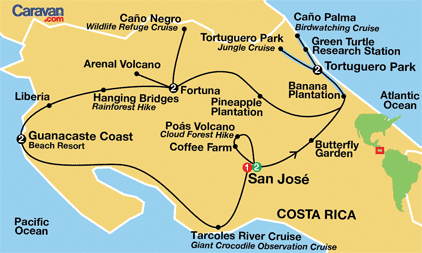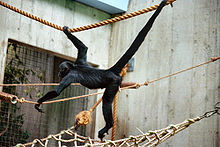 http://www.caravan.com/
http://www.caravan.com/Costa Rica 2012
Brad & Lynn's Costa Rica 2009 Trip Report
Amphibians and Reptiles of La Selva, Costa Rica, and the Caribbean Slope: A Comprehensive Guide - Google Books
Photo Tour - Exotic Bird Photography in Monteverde and Guanacaste, Costa Rica - $3,995 USD (2012) (From March 13: arrived @ San José to March 22: leaving @ Liberia)
What bird? Black-headed Trogon, not Baird's nor Violaceous Trogon
dry or rain in various parts of CR and Carara National Park
Central American whiptailed Lizard (Ameiva festiva) - pic1 more pic of other lizards
Randy M. (from Liberia, Costa Rica) Pictures of Insects in Costa Rica - hubpage - Dragonflies are colloquially called papilachas in Costa Rica, but formal Spanish for them is libelula.
Day 1 – San José, Costa Rica
Welcome to the “rich coast,” friendly land of democracy and rare natural beauty.
With naturalist guides, see exotic birds and wildlife, hike in jungle
rainforests, view volcanoes, soak in hot springs and cruise through biological
reserves. Relax on both the Atlantic and Pacific coasts. Caravan provides
transfers from the Juan Santamaria International Airport (SJO) in San José,
Costa Rica to your hotel for a two night stay. Rooms are available for check in
after 4:00 p.m. Dine at your hotel, then join Caravan for a 8:00 p.m. welcome
briefing.
Day 2 – Poás Volcano, Cloud Forest
This morning, enjoy a drive through Costa Rica’s famous coffee growing region.
Next, visit Poás Volcano. Weather permitting, you can see inside the active
crater from an overlook. Next, hike the Escalonia Cloud Forest Trail, home to
epiphytes, orchids, ferns and tropical hummingbirds.
Cloud forests are like rainforests, but with less rain and more humidity. Lunch.
Next, visit Cafe Brit, a coffee plantation nestled in Barva de Heredia, on the
slopes of the extinct Barva Volcano. Enjoy a guided tour and sample fresh Costa
Rican coffee. Then, see San José’s Plaza de la Cultura, Central Park and the
National Theatre. Dinner.
Day 3 – Butterfly Garden, Tortuguero Park
*Bring Macro lens. At hotel, swimming or look for butterfly/insects at the
garden.
Scenic morning drive through Braulio Carrillo Park. Look for cascading
waterfalls. Visit a butterfly garden. Enjoy lunch. Drive by a banana plantation.
Then, cruise through rivers and canals to the 47,000 acre Tortuguero National
Park. Tortuguero is home to more than 300 species of birds. Look for toucans,
parrots, kingfishers and the rare green macaw. Free
time to enjoy the swimming pool and tropical flower gardens at your lodge (Laguna
Lodge).
Listen to joyful jungle sounds. Enjoy a two night stay at your lodge. Dinner.
Day 4 – Tortuguero Park, Canal Cruise
Cruise this morning with naturalist guides along canals lined by raffia palm,
the habitat of howler and white-faced monkeys, green iguanas and tropical birds.
Look for white and snowy egrets and the amazing nests of the
montezuma oropendola. Then, enter the mysterious
reflecting waters of Caño Palma wildlife reserve. Next, visit the Green Turtle
Research Station. Learn about efforts to protect the turtles. Walk along the
Atlantic turtle nesting beaches with a naturalist guide. Next, to Tortuguero
village. Meet Costa Rican school children on your visit to a local school (when
in session). Return to your lodge for lunch. Enjoy an afternoon boat excursion
into Tortuguero Park. Look for otters, turtles and manatees. Dinner.
Day 5 – Pineapple Tour, Fortuna
Morning cruise on Tortuguero River. Enjoy lunch. Visit a pineapple plantation.
Sample Costa Rica’s famous sweet organic pineapples. Next, through scenic
countryside to the San Carlos Valley for a two night stay in Fortuna. Dinner.
Hotel: Arenal Manoa
The new Arenal Manoa Hotel is located in the countryside on the outskirts of
Fortuna. All rooms are air conditioned with satellite television, telphone,
refrigerator, and a terrace with a panoramic view of
Arenal Volcano. Guests can
enjoy the restaurant, wet bar, swimming pool and jacuzzi. The Arenal Manoa has
spacious gardens, walking trails and the opportunity to experience the daily
operations of a Costa Rican family dairy farm. Internet access is available at
internet cafes in the nearby village of Fortuna for a fee.
More
Day 6 – Caño Negro, Hot Springs, Arenal
Head north this morning, passing through sugar cane, teak and orange
plantations. Then, cruise on the Rio Frio which runs through the world famous
Caño Negro wildlife refuge
(info:
<1> <2>), home to many migratory birds found nowhere else in
Costa Rica. Look for whistling ducks, roseate spoonbills,
cormorants, anhingas, blue heron, and northern jacanas. Watch for
caimans, crocodiles, spider monkeys, and web-footed, water-walking lizards (wiki;
video: <1>; info:
<1>).
Lunch. Return to Fortuna. Then, enjoy a relaxing soak in the volcanic hot
springs. Weather permitting, see nearby Arenal Volcano’s softly glowing lava
flow. Enjoy dinner.
Note of
Caño Negro wildlife refuge:
The 10,000 acre Caño Negro Refuge is a remote tropical everglade with a large
network of rivers and wildlife. It is home to 350 species of birds, as well as
the emerald basilisk, river turtles, caimans, jaguars (美洲豹,
Panthera onca,
也叫美洲虎), ocelots
(山貓), giant anteaters,
monkeys, and many other wild creatures. The best time to visit is
during the rainy season (May to October) when the lake is full.
 Black-headed
Spider Monkey (Ateles fusciceps)
Black-headed
Spider Monkey (Ateles fusciceps)
During the green (rainy) season from May to October, water from the mountains is
plentiful and the Río Frío overflows its banks to form Lago Caño Negro
positioned smack in the middle of the flyway for migrant North and South
American birds. Millions of birds arrive here to winter over during the dry
season beginning in December. The water level falls continuously for the next
three to four months until all that is left is the main channel of the Río Frío
and the migrants depart.
Among the many birds found in Caño Negro are: glossy Ibis, black-necked stilt,
neotropical cormorants, American anhinga, northern jacana, American widgeon,
wood stork, white Ibis, black-bellied tree duck, northern shoveler, snail kite,
green backed heron, roseate spoonbill, and blue-winged teal. This is one of the
best places to see the Nicaraguan grackle, whose only Costa
Rican habitat is Caño Negro and other marshy areas just south of Lake Nicaragua.
Day 7 – Hanging Bridges, Guanacaste
Day 8 – Pacific Coast, Guanacaste
Day 9 – Tarcoles Cruise, San José
This morning enjoy an unforgettable adventure in the heart of the rainforest at
the Hanging Bridges, rated one of Costa Rica’s top tourist attractions. Hike on
six suspension bridges, through lush tropical rainforest canopy. Enjoy views of
a waterfall and look for tropical birds. Later, a scenic drive around Lake
Arenal. Enjoy lunch. Next, enter the Guanacaste province. Drive through the only
tropical dry forest in Costa Rica. Stop in Liberia. Then, to Costa Rica’s
beautiful Pacific Coast for a two night stay. Dinner is at your resort.
bird species found in Guanacaste
Hotel: J.W. Marriott Resort and Spa
The elegant, new JW Marriott Guanacaste Resort and Spa is located on Costa
Rica's northwestern coast. This oceanfront resort is on a pristine secluded
beach surrounded by a natural sanctuary with extensive landscaped gardens.
The resort has a full service spa and the largest pool in Costa Rica (over
25,000 square feet) with a sunken swim-up bar. The spacious guest rooms are
each furnished with a private balcony or terrace. Guest rooms feature luxury
bathrooms with a separate deep soaking bathtub and shower.
Whole day at leisure to enjoy your magnificent beach resort. Swim in your
hotel's infinity pool, the largest in Central America, indulge yourself in
the world class spa or just simply relax. Lunch. Enjoy a carefree afternoon.
Time to beachcomb or stroll the pristine beaches of your resort. Dinner.
Morning drive through the cattle ranches of Guanacaste. Lunch. Next, enjoy a
bird and crocodile spotting cruise on the Tarcoles River, adjacent to the
Carara Biological Reserve. Cruise through a mangrove reserve. This tropical
bird and wildlife sanctuary is a nesting site for the
scarlet macaw. Return to San José. Farewell dinner.
Day 10 – San José
Your tour ends after breakfast this morning at your hotel. Breakfast begins at
6:30 a.m. Caravan provides transfers to the Juan Santamaria International
Airport (SJO) in San José, Costa Rica arriving at 5:00 a.m, 7:00 a.m, 9:00 a.m.,
and 11:30 a.m.. Thanks for vacationing with Caravan. ¡Hasta
la vista!